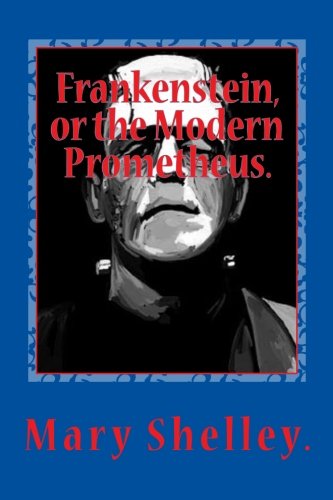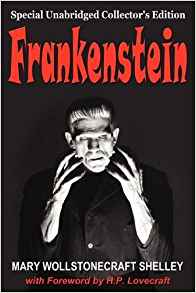-
Frankenstein, the Modern Prometheus by Shelley, Mary Wollstonecraft
Mary Wollstonecraft Shelley
Paperback (Bottom of the Hill Publishing Jul - 2014, Jan. 1, 1651)None
-
Frankenstein, or the Modern Prometheus.
Mary Shelley.
Paperback (CreateSpace Independent Publishing Platform, Dec. 30, 2015)Frankenstein; or, The Modern Prometheus is a novel written by the English author Mary Wollstonecraft Shelley that tells the story of a young science student Victor Frankenstein, who creates a grotesque but sentient creature in an unorthodox scientific experiment. Shelley started writing the story when she was 18, and the first edition of the novel was published anonymously in London in 1818, when she was 20. Shelley's name first appeared on the second edition, published in France in 1823. Z+
Z+
-
Frankenstein or the Modern Prometheus
Mary Shelley
Hardcover (Simon & Brown, Nov. 5, 2018)None Z+
Z+
-
Frankenstein, or the Modern Prometheus
Mary Shelley, Vito Inguglia, Paul Meighan
(Easy Peasy Publishing, May 15, 2014)• New Introduction• Analysis and interpretation of novel • Complete, unabridged, and formatted for kindle to improve your reading experience• Linked table of contents to reach your chapter quicklyFrankenstein; or, The Modern Prometheus is about an eccentric scientist Victor Frankenstein, who creates a grotesque creature in an unorthodox scientific experiment. Mary Shelley started writing the story when she was eighteen, and the novel was published when she was twenty. The first edition was published anonymously in London in 1818 but Shelley's name appears only on the second edition, published in France in 1823.
-
Frankenstein by Mary Wollstonecraft Shelley
None
Mass Market Paperback (NMD Books, Feb. 25, 1750)None
-
Frankenstein, Or, the Modern Prometheus
Mary Wollstonecraft Shelley
Hardcover (Franklin Classics, Oct. 7, 2018)This work has been selected by scholars as being culturally important and is part of the knowledge base of civilization as we know it.This work is in the public domain in the United States of America, and possibly other nations. Within the United States, you may freely copy and distribute this work, as no entity (individual or corporate) has a copyright on the body of the work.Scholars believe, and we concur, that this work is important enough to be preserved, reproduced, and made generally available to the public. To ensure a quality reading experience, this work has been proofread and republished using a format that seamlessly blends the original graphical elements with text in an easy-to-read typeface.We appreciate your support of the preservation process, and thank you for being an important part of keeping this knowledge alive and relevant.
-
Frankenstein; Or, The Modern Prometheus
Mary Wollstonecraft Shelley
(Independently published, Feb. 1, 2020)Frankenstein or The Modern Prometheus, was completed by Mary Shelley at the age of 19. She infused this original novel with Gothic and Romantic elements. Scientist Victor Frankenstein creates a large and powerful creature in the likeness of man, but is disgusted by his own creation and he abandons the being to fend for itself. Spawning generations of horror stories in the genre, Frankenstein is a gruesome warning against playing God and attempting the engineering of life.
-
Frankenstein: Or, the Modern Prometheus
Mary Shelley
Paperback (CreateSpace Independent Publishing Platform, Dec. 11, 2015)Frankenstein is the classic gothic horror novel which has thrilled and engrossed readers for two centuries. Written by Mary Shelley, it is a story which she intended would ‘curdle the blood and quicken the beatings of the heart.’ The tale is a superb blend of science fiction, mystery and thriller. Victor Frankenstein driven by the mad dream of creating his own creature, experiments with alchemy and science to build a monster stitched together from dead remains. Once the creature becomes a living breathing articulate entity, it turns on its maker and the novel darkens into tragedy. The reader is very quickly swept along by the force of the elegant prose, the grotesque, surreal imagery, and the multi-layered themes in the novel. Although first published in 1818, Shelley’s masterpiece still maintains a strong grip on the imagination and has been the inspiration for numerous horror movies, television and stage adaptations. Z+
Z+
-
Frankenstein; Or, The Modern Prometheus
Mary Wollstonecraft Shelley
(Independently published, May 1, 2020)Frankenstein or The Modern Prometheus, was completed by Mary Shelley at the age of 19. She infused this original novel with Gothic and Romantic elements. Scientist Victor Frankenstein creates a large and powerful creature in the likeness of man, but is disgusted by his own creation and he abandons the being to fend for itself. Spawning generations of horror stories in the genre, Frankenstein is a gruesome warning against playing God and attempting the engineering of life.
-
Frankenstein; or, The Modern Prometheus
Mary Wollstonecraft Shelley
(CreateSpace Independent Publishing Platform, Jan. 20, 2018)Frankenstein; or, The Modern Prometheus by Mary Wollstonecraft Shelley
-
Frankenstein; Or, The Modern Prometheus
Mary Shelley
Hardcover (Bibliotech Press, Sept. 15, 2020)Frankenstein; or, The Modern Prometheus is an 1818 novel written by English author Mary Shelley (1797-1851) that tells the story of Victor Frankenstein, a young scientist who creates a sapient creature in an unorthodox scientific experiment. Shelley started writing the story when she was 18, and the first edition was published anonymously in London on 1 January 1818, when she was 20. Her name first appeared in the second edition published in Paris in 1821.Shelley travelled through Europe in 1815 along the river Rhine in Germany stopping in Gernsheim, 17 kilometres (11 mi) away from Frankenstein Castle, where two centuries before, an alchemist engaged in experiments. She then journeyed to the region of Geneva, Switzerland, where much of the story takes place. The topics of galvanism and occult ideas were themes of conversation among her companions, particularly her lover and future husband Percy B. Shelley. In 1816, Mary, Percy and Lord Byron had a competition to see who could write the best horror story. After thinking for days, Shelley dreamt about a scientist who created life and was horrified by what he had made, inspiring the novel.Though Frankenstein is infused with elements of the Gothic novel and the Romantic movement, Brian Aldiss has argued that it should be considered the first true science fiction story. In contrast to previous stories with fantastical elements resembling those of later science fiction, Aldiss states the central character "makes a deliberate decision" and "turns to modern experiments in the laboratory" to achieve fantastic results. It has had a considerable influence in literature and popular culture and spawned a complete genre of horror stories, films and plays.Since the publication of the novel, the name "Frankenstein" has often been used to refer to the monster itself. (wikipedia.org)
-
Frankenstein: Or the Modern Prometheus
Mary Wollstonecraft Shelley
eBook (, Oct. 5, 2018)This is the Uncensored First 1818 Edition of FRANKENSTEIN written by female author Mary Wollstonecraft Shelley. Be touched by this classic tale of horror and humanity.Shelley's enduringly popular and rich gothic tale, Frankenstein, confronts some of the most feared innovations of evolutionism and science--topics such as degeneracy, hereditary disease, and humankind's ability to act as creator of the modern world. This new edition, based on the harder and wittier 1818 version of the text, draws on new research and examines the novel in the context of the controversial radical sciences developing in the years following the Napoleonic Wars. In addition it shows the relationship of Frankenstein's experiment to the contemporary debate between champions of materialistic science and proponents of received religion